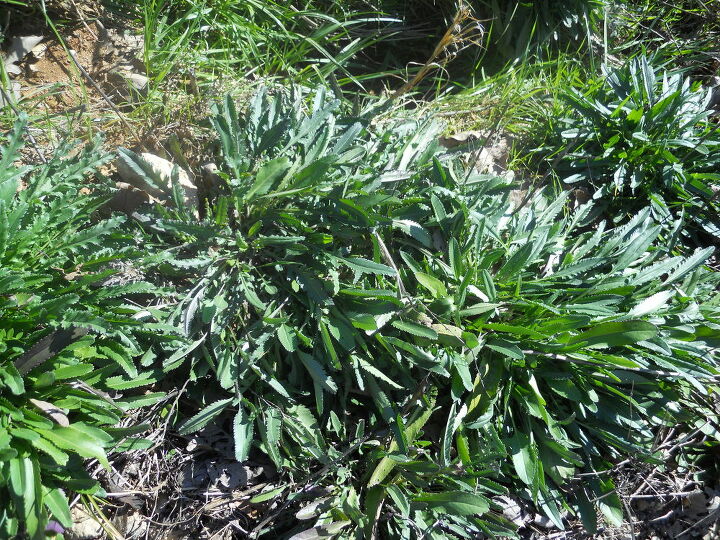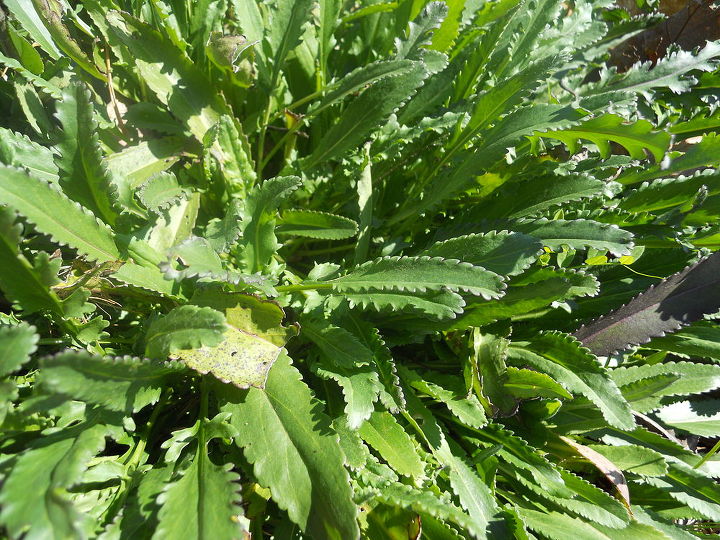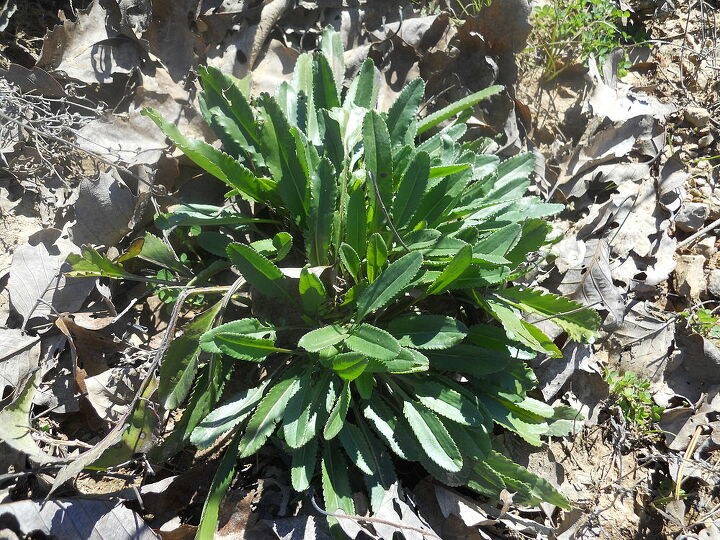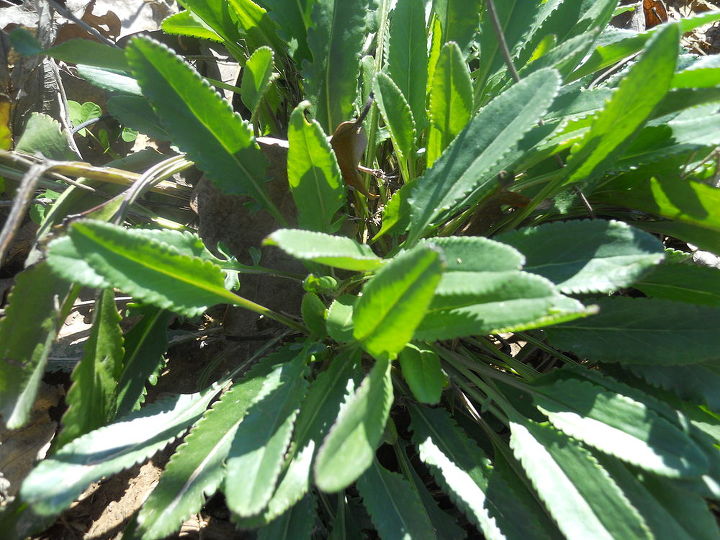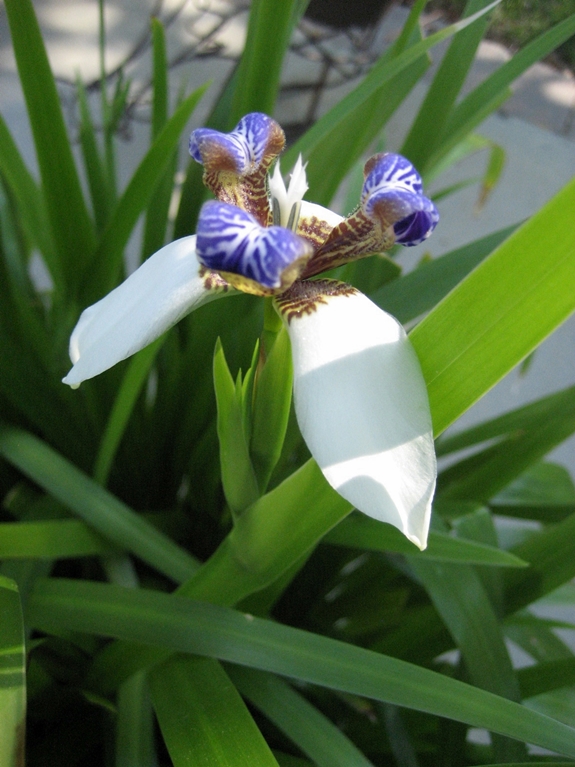Walter, Erica, and all you horticulture experts...What is this weed thriving in our pasture? How do we get rid of it?

-
I don't know! But I just noticed some in my yard too! Hopefully someone will come along and inform us...
 Caitlin M
on Feb 26, 2012
Helpful Reply
Caitlin M
on Feb 26, 2012
Helpful Reply -
-
Take your pictures to Lowes Garden Center. They have a book of almost every plant/weed under the sun and many animal friendly chemicals. Be ware though - I had to have my mare put down for eating some kind of weed in the pasture that attacked her central nervous system and she could not keep on her feet. Also, you could ask your vet the same questions about how long to keep the horses away. Good luck!
 Terri J
on Feb 27, 2012
Helpful Reply
Terri J
on Feb 27, 2012
Helpful Reply -
-
I looked through several of my weed ID books, but I did not find an exact match. I could not find anything that had the same edges on the leaf blades that your photos show. You can try to ID it on this website. It does get quite technical, but you can always select 'Don't Know' and it should help narrow the list. http://web2.ento.vt.edu/servlet/wid?table=grasses
 Southern Trillium LLC
on Feb 27, 2012
Helpful Reply
Southern Trillium LLC
on Feb 27, 2012
Helpful Reply -
-
Thank you all for the helpful advice.
 Culpepper Carpets and Interiors, Inc.
on Feb 28, 2012
Helpful Reply
Culpepper Carpets and Interiors, Inc.
on Feb 28, 2012
Helpful Reply -
-
Lee Anne, here is a chart of the grazing restrictions for a number of common herbicides. This information should be on the label on the herbicide as well. I found it a little disturbing that widely used Roundup has far and away the longest period of time you should keep animals away. http://dumpbear.com/Forestry/Herbicide/2-4DandHorses.pdf You really should know the weed before applying an herbicide and I have to admit yours has me stumped as well. If there's one fairly near you, I would recommend taking a clump to your local Cooperative Extension office. Here is a list by county: http://extension.uga.edu/about/county/index.cfm
 Douglas Hunt
on Feb 28, 2012
Helpful Reply
Douglas Hunt
on Feb 28, 2012
Helpful Reply -
-
OK - I have three expert opinions (two PHD's and one Masters degree). One says may be a member of the Senecio species, one says a member of the dock family and one says it looks a lot like Stachys densiflora...but isn't. All agree that the photos are excellent but that final ID would come from seeing a flower. Since it's a broadleafed plant you could control it with Weedmaster.
 Walter Reeves
on Feb 28, 2012
Helpful Reply
Walter Reeves
on Feb 28, 2012
Helpful Reply -
-
I am not a weed expert but it does look like it could be a senecio species now that you mention it. Keep us posted, yes we need the flowers.
 Erica Glasener
on Feb 28, 2012
Helpful Reply
Erica Glasener
on Feb 28, 2012
Helpful Reply -
-
This is a good one! you had me searching for awhile and still clueless. hope someone IDs it.....Im interested to find out.
 Surrounding Landscapes Inc.
on Feb 28, 2012
Helpful Reply
Surrounding Landscapes Inc.
on Feb 28, 2012
Helpful Reply -
-
Thank you all! Walter please thank your associates for me. You have all gone to a lot of trouble, I really thought it would be a common weed. They are really rampant in our pasture, so when the little beasties do bloom...it will be a floral garden! I can not express my appreciation for your help.
 Culpepper Carpets and Interiors, Inc.
on Feb 28, 2012
Helpful Reply
Culpepper Carpets and Interiors, Inc.
on Feb 28, 2012
Helpful Reply -
-
Mr Doc the horse should know!
 Yamini LEED AP at Urbanmotifs
on Feb 28, 2012
Helpful Reply
Yamini LEED AP at Urbanmotifs
on Feb 28, 2012
Helpful Reply -
-
Doc is so lazzzy, he prefers to have is hay delivered!
 Culpepper Carpets and Interiors, Inc.
on Feb 29, 2012
Helpful Reply
Culpepper Carpets and Interiors, Inc.
on Feb 29, 2012
Helpful Reply -
-
Lee Anne: Does Georgia have a Horticular website? Or, perhaps, a Master Gardener's website? If so, it might be of some help. Otherwise, please give Mr. Doc rubs, hugs & kisses from a California advid animal lover ~~ ! Good Luck & I wish you success in finding that answer.
 Bonnie B
on Mar 01, 2012
Helpful Reply
Bonnie B
on Mar 01, 2012
Helpful Reply -
-
Just wondering aloud ... instead of spraying a plant poison ON the offending plant, what about using one of those devices that has a syringe on the bottom? So the plant poison is injected into the root area. This way the horse should not be in danger because the poison kills the roots which makes the plant die due to lack of water and nutrients. Terry Thomas / Dunwoody Organic Gardens
 Terry
on Mar 01, 2012
Helpful Reply
Terry
on Mar 01, 2012
Helpful Reply -
-
Terry, that is a marvelous Idea, but it is 5 acres and they have popped up about every 5 feel. We can keep the horses in the arena and hay them for a month or longer to be sure. Thank you Bonnie, we love our animals too. I think we will spray with weed killer that is recommended for pastures and keep them off as stated above.
 Culpepper Carpets and Interiors, Inc.
on Mar 02, 2012
Helpful Reply
Culpepper Carpets and Interiors, Inc.
on Mar 02, 2012
Helpful Reply -
-
Lee Anne, doesn't it sound as though the horses are eating something then ummm ... "distributing" the seeds themselves? :-)
 Terry
on Mar 03, 2012
Helpful Reply
Terry
on Mar 03, 2012
Helpful Reply -
-
No, the pasture is new and does not sustain them, therefore they hang around the arena where the hay roll is. The manure is mostly up there & we scoop it & put it in a pile for gardening.
 Culpepper Carpets and Interiors, Inc.
on Mar 03, 2012
Helpful Reply
Culpepper Carpets and Interiors, Inc.
on Mar 03, 2012
Helpful Reply -
-
Let's dream that dream together!!!
 Culpepper Carpets and Interiors, Inc.
on Mar 03, 2012
Helpful Reply
Culpepper Carpets and Interiors, Inc.
on Mar 03, 2012
Helpful Reply -
-
If so, will you share the wealth with all? I just need enough to level my backyard?!
 Terri J
on Mar 03, 2012
Helpful Reply
Terri J
on Mar 03, 2012
Helpful Reply -
-
They kind of look like a little bit like a 1st generation, slightly deformed from dehydration (maybe), type of Hosta. That's the closest thing that I can think of them coming to looking like. And Hosta's grow like wild fire. That's pretty much the only thing that I could find that looks vaguely familiar to your picture and (plus we have neighbors with tons of them, so we see them in all weather), and I read what I could find online. Good luck!!!!
 Nyomi R
on Mar 03, 2012
Helpful Reply
Nyomi R
on Mar 03, 2012
Helpful Reply -
-
Thank you Nyomi, what ever they are is useless in a pasture, as the horses do not eat them. Yes Terri, we can spend it together on our DIY projects, mine are going to last me the rest of my days to complete!
 Culpepper Carpets and Interiors, Inc.
on Mar 03, 2012
Helpful Reply
Culpepper Carpets and Interiors, Inc.
on Mar 03, 2012
Helpful Reply -
-
LA - any progress on identifying this plant?
 Walter Reeves
on Mar 25, 2012
Helpful Reply
Walter Reeves
on Mar 25, 2012
Helpful Reply -
-
Thank you Walter. I am afraid not, and no flowers have appeared. The weed are abundant and we are wondering if they came from the chicken manure that Greg spread? He sprayed some with a chemical & the wilted a little. He is looking into buying a spray that chemically nourishes the soil? I will send him this link so that he can ask your opinion.
 Culpepper Carpets and Interiors, Inc.
on Mar 26, 2012
Helpful Reply
Culpepper Carpets and Interiors, Inc.
on Mar 26, 2012
Helpful Reply -
-
OK - keep us posted!
 Walter Reeves
on Apr 03, 2012
Helpful Reply
Walter Reeves
on Apr 03, 2012
Helpful Reply -
-
Okay Walter, it has a yellow flower now. Here is a photo.
 Culpepper Carpets and Interiors, Inc.
on Apr 04, 2012
Culpepper Carpets and Interiors, Inc.
on Apr 04, 2012
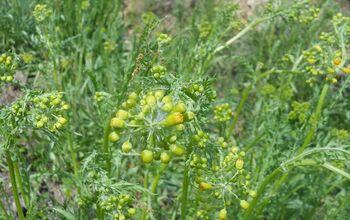
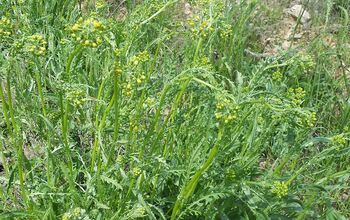 Helpful Reply
Helpful Reply -
-
When ya'all figure out what it is, please let me know. i think some birds dropped some seeds off around here on their way north. Between blue/purple/white/yellow weeds (floweres), I will soon have a very colorful yard!
 Terri J
on Apr 04, 2012
Helpful Reply
Terri J
on Apr 04, 2012
Helpful Reply -
-
Sheila, is there anything that you cannot do? I think you nailed it! It sure looks like our weed & fits the description. Walter, what do you think?
 Culpepper Carpets and Interiors, Inc.
on Apr 04, 2012
Helpful Reply
Culpepper Carpets and Interiors, Inc.
on Apr 04, 2012
Helpful Reply -
-
Lee Anne, I was just checking out that website above for the "Prickly Lettuce" and I'm not totally convinced that that is what you have. I hate being a bubble burster, but let me do a little more research and check back in with you.
 Nyomi R
on Apr 27, 2012
Helpful Reply
Nyomi R
on Apr 27, 2012
Helpful Reply -
-
http://www.ppws.vt.edu/scott/weed_id/lacse.htm http://www.ipm.ucdavis.edu/PMG/WEEDS/prickly_lettuce.html http://www.omafra.gov.on.ca/english/crops/facts/03-041.htm http://montana.plant-life.org/species/lactuca_serrio.htm Here are 4 Different links to "Prickly Lettuce". Although it looks similar to what you have, the patterns of the flowering is different and the plant itself is a lot more narrow. Also, this plant does not flower until between July and September. There is a lot of information in the 4 links that I have provided. Read through them when you get a chance. This should help you be able to determine whether is is or ISN'T for SURE "Prickly Lettuce". Good luck and keep us posted. I have some books that I don't think are packed away yet (I'm in the process of moving), and If I have a chance today, I will try and see if I can find your mystery plant in one of them. Also, keep in mind, that this may not be a "Weed" at all. It may be a regular plant that is just a "pest" to you because it is taking over your pasture. We may be looking in all the wrong places by looking under the "weed" category.
 Nyomi R
on Apr 27, 2012
Helpful Reply
Nyomi R
on Apr 27, 2012
Helpful Reply -
-
Nyomi, I have been reading some of your posts & want to tell you how much I have enjoyed them. Thank you for your research and thoughtful comments. The weeds are now in full bloom, they actually look pretty...LOL!!! They are about 2 to 3 feet tall with lots of golden flowers. I will be home this weekend & will post photos of the beasts.
 Culpepper Carpets and Interiors, Inc.
on Apr 27, 2012
Helpful Reply
Culpepper Carpets and Interiors, Inc.
on Apr 27, 2012
Helpful Reply -
-
Please do post more...this continues to intrigue me, particularly because the yellow flowers seem to be arranged in a whorl at the top of the stem.
 Walter Reeves
on Apr 28, 2012
Helpful Reply
Walter Reeves
on Apr 28, 2012
Helpful Reply -
-
I will take photos tomorrow & post, thank you.
 Culpepper Carpets and Interiors, Inc.
on Apr 28, 2012
Helpful Reply
Culpepper Carpets and Interiors, Inc.
on Apr 28, 2012
Helpful Reply -
-
Okay Walter, here are my floral weeds!
 Culpepper Carpets and Interiors, Inc.
on Apr 29, 2012
Culpepper Carpets and Interiors, Inc.
on Apr 29, 2012
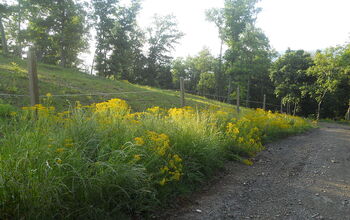
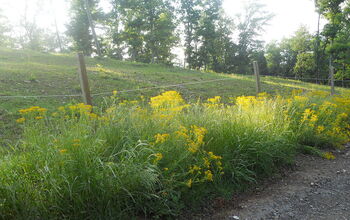
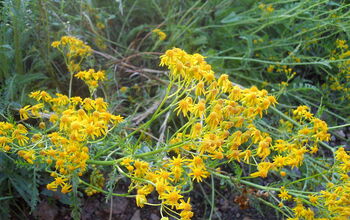
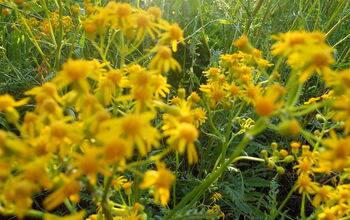

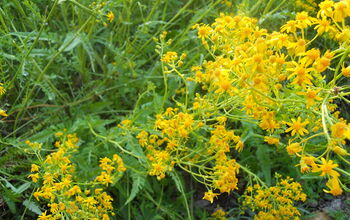

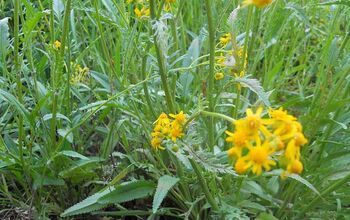 Helpful Reply
Helpful Reply -
-
Lee Ann, I think you have ragwort, the scientific name of the genus is Senecio. I believe this is an invasive exotic pest (what a term!) but the flowers sure are pretty. I can't swear to the particular species but the ferny foliage with flowers looks like Senecio. Here is a link with some photos. This plant causes allergies for some and I thought it usually blooms later but it has been a crazy spring with things blooming a month or six weeks earlier than in previous years. Hope this helps. http://www.bing.com/images/search?q=Common+Ragwort&FORM=R5FD#x0y0
 Erica Glasener
on Apr 30, 2012
Helpful Reply
Erica Glasener
on Apr 30, 2012
Helpful Reply -
-
Oh my gosh! I think you nailed it! How do I kill the blasted stuff & not hurt the horses? I can keep them in the upper arena for a week or so. Thank you!
 Culpepper Carpets and Interiors, Inc.
on Apr 30, 2012
Helpful Reply
Culpepper Carpets and Interiors, Inc.
on Apr 30, 2012
Helpful Reply -
-
OK - after more searching I think it is Packera paupercula (syn Senecio pauperculus). I base this on the toothed margin to the young leaves we saw in LA's very first post. Erica - your thoughts?
 Walter Reeves
on May 01, 2012
Helpful Reply
Walter Reeves
on May 01, 2012
Helpful Reply -
-
Thank you both for taking on this challenge. I want to find out what to use to get rid of them, they are rampant.
 Culpepper Carpets and Interiors, Inc.
on May 01, 2012
Helpful Reply
Culpepper Carpets and Interiors, Inc.
on May 01, 2012
Helpful Reply -
-
I agree it is a Senecio or Packera but not certain on the species. Either way it is a pest for Lee Anne.
 Erica Glasener
on May 01, 2012
Helpful Reply
Erica Glasener
on May 01, 2012
Helpful Reply -
-
For those that run across this thread (as I just did!) 3 yrs. later. This plant is Packera paupercula, or Packera anonyma aka Small's ragwort. I had it in my pasture here in northeast TN. It is native to the entire Piedmont area. From our Ag agent: "Many members of the senecio genus are poisonous and can cause an ailment known as seneciosis. They are known to contain some combination of liver-damaging pyrrolizidine alkaloids such as jacobine, retrorsine, senecifoline, and senecine. Livestock or humans that ingest Small’s Groundsel can exhibit symptoms that include jaundice, cirrhosis of the liver, phtosensitization, and central nervous system disruptions such as clumsiness and confusion" . Well when I read THAT, I went on a mission to rid the pasture of it. Started out with digging up (at the roots) as many as I could (at first). Which was rather futile! This stuff breeds/spreads faster than RABBITS!!! So, I opted for our fave home made weed killer (safe for use around humans & animals!) Here's our recipe: In a 2 gallon pump sprayer (our weapon of choice as its light weight enough when filled for me to use) 2 cups Epsom salts, 1 gallon vinegar, 1 gallon water, 1/8 cup original blue Dawn dish soap. It took 2 applications on each clump, but it got it!!
 Cher B
on Aug 11, 2015
Helpful Reply
Cher B
on Aug 11, 2015
Helpful Reply -
-
If anyone has an issue like this in the future, Contact your local County Extension Office (Google, phone book, or college will direct). You can email them a pic or take a sample in. You can do the same with any plant or tree. They can also diagnose any disease and tell you how to treat. Soil samples can be taken in as well to discover pH prior to planting as many plants grow best in a certain pH range.
 Patty
on Sep 03, 2016
Helpful Reply
Patty
on Sep 03, 2016
Helpful Reply -
Related Discussions
GNATS - How to get rid of them?
Somehow my house and garden got tiny gnats that killed my fuchsia plant and fly everywhere. I have tried ALL the Web recommendations - soap and oil dishes, sand in th... See more
Marigolds growing! Should I pinch the buds?
My marigold plants are growing. I heard that pinching the buds until Autumn will allow them to grow without killing the plant. Is this true?
Growing garlic
Growing our first garlic, should we wait until the leaves are drying out before we pick it? Husband picked first one today along with our first potatoes.
How to keep mice out of your garden?
Hi everyone, I have mice in my garden destroying my vegetables and I have also noticed them in the barn and shed. Please can someone tell me how to prevent them from ... See more
What's the best flower/plant to grow in Texas?
I know that opinions vary, but what's your opinion?!I have great luck w Rosemary plants. Green all year long.
What is the name of this plant?
I was given this plant 8 years ago or so and was told it was an "orchid plant"...not an orchid, but an orchid plant. I was told to keep it potbound and it would bloom... See more
Does anyone know what kind of plant this is?
I have several of these volunteering in various places this year. I don't know what it is and it hasn't bloomed yet. In the picture it's the leafy green one in the mi... See more
